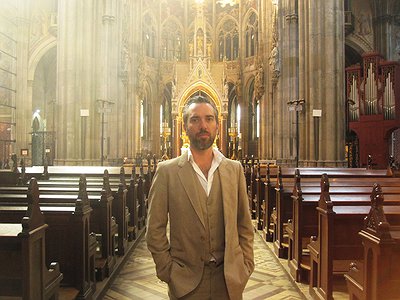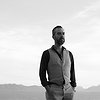How do you make use of technology? In terms of the feedback mechanism between technology and creativity, what do humans excel at, what do machines excel at?
Technology (techne) is what we create – technology is made by people, I try not to engage with the technological determinist idea, that technology leads us, but more so that social, cultural and particularly economic forces shape it – the profit-motive often being at the core of these. I tend to use the simplest tools, trying to work from simple principles and the material nature of these tools. I’ve finally realised that most of them seem to relate to air in some way – be it pipe organs, field recordings and weather, architectural volumes – they are all subject to temperature, humidity and pressure, which perhaps amusingly all have their way with technology in one way or another.
Collaborations can take on many forms. What role do they play in your approach and what are your preferred ways of engaging with other creatives, including the artists performing your work?
I like the energy and input that other people bring into collaborations – it refreshes the process and takes it to places I wouldn’t think of myself. Everyone is different so I can’t generalise, but I’m looking forward to working more with other people again after a period of working often by myself for a variety of reasons, among them limitations on travel possibilities over the past 6 years.
How is writing the music and having it performed live connected? What do you achieve and draw from each experience personally? How do you see the relationship between improvisation and composition in this regard?
The sound is the music, I’m not really able to notate it as often the timbre is as important as the pitch, the durations, the interactions of harmonics. So the recordings are always a performance of sorts, capturing that particular sound and its inherent interactions within its constituent elements. So too live performances are working with these same ideas and overtones – within a given architectural volume if indoors or a weather-system if outdoors. Responding to these conditions is part of the performance, an attendant improvisation with these in-situ elements in the realisation of the piece and also how they fluctuate throughout the piece. The differences in these interactions was why I recently released the two live versions of Tailte Cré-Umha (Bronze Lands) which is for pipe organ and soundsystem – they are both the same piece but very much shaped by the instrument and circumstance of the performance – one a digital release of sections of the premiere performance in a Cathedral in Ireland (with its attendant reverb) on a 32ft pipe organ with 10ft dub soundsystem, the other the full performance in the very different architectural volume of the Sydney Town Hall with its 64ft grand pipe organ and soundsystem including twelve 18” subs. On both occasions the weather was very different, particularly the humidity, which affects the speed of sound and interaction of overtones within these large but very different architectures.
Time is a variable only seldomly discussed within the context of contemporary composition. Can you tell me a bit about your perspective on time in relation to a composition and what role it plays in your work?
I find duration a more useful term – as employed by Bergson and subsequently Deleuze – and equally rather than ‘space’ or ‘place’ I prefer the specificity of ‘location’. Together they help realise context, something that I’m aiming to refer to with the answers to these questions. To be freed from context is not necessarily to negate the power structures which determine both freedom and context, but to be privileged enough to “have all the time in the world” is perhaps an expression of the context within which an artist can fill all the time available to them. This raises questions in- itself or of-themselves, including again about privilege. On a different tack, durations, or time pressure, have a topology of their own – particular harmonics at specific points over certain durations – and these durational topologies, in terms of a performance or piece, can be made to be concomitant with changes in sound pressure; but different mental states and responses set in at different points along these temporal trajectories over different durations – that is, different durations of pieces take an audience to different places at different junctures.
How do you see the relationship between the 'sound' aspects of music and the 'composition' aspects? How do you work with sound and timbre to meet certain production ideas and in which way can certain sounds already take on compositional qualities?
Music is made of sound, composition is working out where to put them, the silences and the balance between them, or not. Sound is timbral – timbre is qualitative and the notion of timbre is what distinguishes one sound from another – enacting the combination of those timbres, is that not the compositional process?
Our sense of hearing shares intriguing connections to other senses. From your experience, what are some of the most inspiring overlaps between different senses - and what do they tell us about the way our senses work? What happens to sound at its outermost borders?
Tactile and physical senses are probably the most inspiring overlaps for me. When I was around 10 I caused a plate to come off a shelf – as mentioned I was fascinated with the bass on the Hammond and was playing with the pedals when I heard a crash and found a plate in the middle of the next room – making the connection between excessive bass and the physicality of sound and vibration, that ‘bass did this’, was a big realisation for me. Many years later, on a European tour in 2013, at the venue A4 in Bratislava, the bass from the performance caused a glass to come off the shelf at the other end of the venue, a loud crash between the compressions and rarefactions in a sliver of silence that was accompanied by the response of the bar staff. Since then taking objects off shelves with specific low bass frequencies in soundchecks has been a bit of a game as part of tuning to the room.
Another sensory overlap one wouldn’t expect is with smell - I’ve had to warn people at venues that for some pieces the bass (below 30hz) can shake the old dust out of the ceiling, which releases an ozone smell. Ozone is usually typified as the “photocopier smell”, it alarms people a bit for good reason, but not so long ago a particular venue had a different ozone smell to it, like the ozone used for swimming pool filtration, which was a new one for me.
I suppose in all my interest in sound is specifically these borders, where one thing becomes another in the permeability of phase shifts.
Art can be a purpose in its own right, but it can also directly feed back into everyday life, take on a social and political role and lead to more engagement. Can you describe your approach to art and being an artist?
Artwork is connected to the mode of being of both the creator/artist and audience/receiver of the artwork but in different ways. Everyday life is where the economics, power structures and sociocultural relations play out – which shape us and also delimit, allow or restrict what we can be. Working as much as making art is a social role, it is a political role and it is an engagement in-itself.
It is remarkable, in a way, that we have arrived in the 21st century with the basic concept of music still intact. Do you have a vision of music, an idea of what music could be beyond its current form?
Melody’s connection with 18th century Viennese music is a relatively new arrival, so the preservation of this form into the 21st century is perhaps itself a distortion – one equally connected to the preservation of power structures evident now as they were then in Europe and European music. The 21st century promises of the highest possible musical fidelity are also subservient to, or paradoxically at odds with, capital’s preference for consuming music at low bitrates and compression levels above that of the popular cassette form of the 20th century (1:6 for a tape, 1:7 for the best mp3s). The question of survival, as Benjamin noted, is not just surviving but what survives – what is lost or changed in the process – and living as we are now in his age of mechanical reproduction, a subversion of this mechanical reproduction and a new vision of music could be one of clarity, where the experience of sound is connected to a greater possibility of collective freedom, where we hear this music collectively (not just as isolated individuals) but as an audience and the ideas driving the sound are embraced beyond their current, very reduced and consumer-driven forms.



